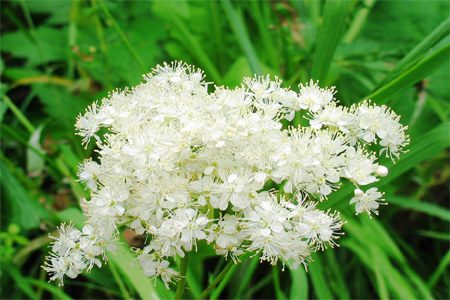
Meadowsweet (lat. Filipéndula) is a representative of the pink family. Perennial grass, which is often called meadowsweet, lungwort, whitehead, spirea among the people. A beautiful, delicate plant is loved by gardeners for its exceptional decorative qualities.
For centuries, traditional medicine has included meadowsweet in the formulation of painkillers, diuretics, and anti-inflammatory compounds. Modern doctors use it in the complex therapy of a number of diseases. The study of the composition of the meadowsweet made it possible to reveal the secret of useful qualities. It turned out that the anti-inflammatory effect is manifested due to tannins and salicylates.
We will talk about the medicinal properties of the meadowsweet, its varieties, we will teach you how to prepare healing remedies on the basis of this incredibly delicate and beautiful herb.
What does the meadowsweet look like and where does it grow?
The meadowsweet is called the king of meadows and honey plants. The most diverse plant species are found in Asia, Europe, North America, Ireland and England. The grass loves moist soil, and therefore grows on river banks, wetlands.
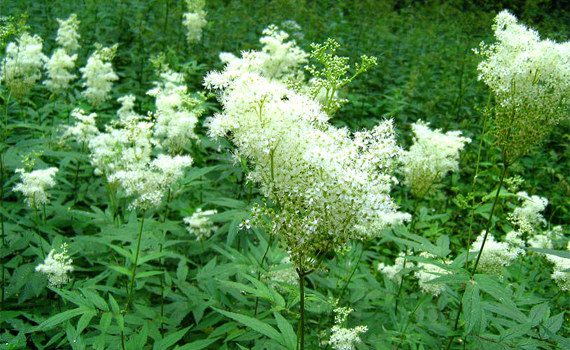
Varieties of meadowsweet are distinguished by external characteristics, but they are all united by common features:
High stem – up to 2 meters.
Powerful, long root.
Large pinnate leaves.
Paniculate corymbose inflorescences formed by small flowers.
In the structure of the flower, 6 petals are determined.
In landscape and landscape gardening design, the excellent decorative qualities of the meadowsweet are valued. The peak of flowering occurs in the summer months. The flowers of the meadowsweet are distinguished by a pleasant, light smell with sweetish notes. Over time, fruits appear in place of flowers – pubescent leaflets or multi-nuts.
For medicinal purposes, flowers, meadowsweet roots are used. Teas, decoctions, extracts, infusions are prepared from them, useful for colds, heartburn, gout, diseases of the stomach and joints. Meadowsweet is traditionally used as a natural diuretic for infectious processes in the kidneys and bladder.
In cooking, meadowsweet pollen is valued. Its delicate aroma and sweet taste enhance the taste of mead and some other drinks.
Types of meadowsweet
Scientists have studied at least 16 varieties of meadowsweet. Let us dwell on the most popular and valuable for a person.
Common meadowsweet (lat. (Filipendula vulgaris)
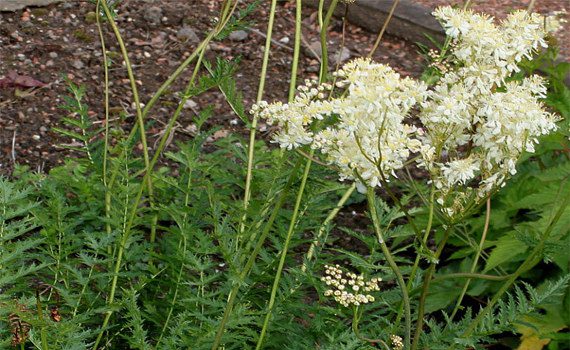
Several shoots of the common meadowsweet form a rather lush bush up to 80 cm in height. Pinnate leaves grow densely on the lateral stems. The central shoot during the flowering period is crowned with panicle inflorescences formed by the most delicate cream flowers.
Meadowsweet is common in meadows, forest edges, and is found in the steppes. It is valued as a good summer honey plant, from which a lot of pollen and nectar are obtained.
It is in the meadowsweet that astringent, diuretic, and hemostatic properties are most pronounced, therefore this type of plant is most often used in scientific medicine.
Elm-leaved meadowsweet (lat. Filipendula ulmaria)
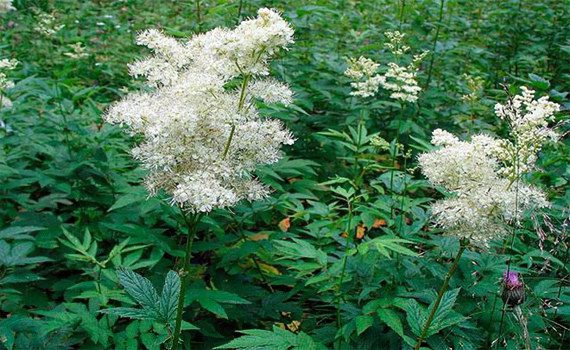
Elm-leaved meadowsweet is more common than other species in Russia. A favorite place of growth is the banks of rivers, lakes, grassy swamps. The herbaceous plant is a perennial tall bush, reaching 1,5 – 2 meters.
The leaves of the meadowsweet are pinnate, dark green in color. In late June – early July, rather large cream flowers appear, collected in loose panicles. The size of one inflorescence is up to 20 cm in length.
To date, meadowsweet is used in folk medicine, and is also included in the register of the official pharmacopoeia of Russia. This plant is used as an anticonvulsant, anti-inflammatory and bactericidal agent.
Meadowsweet is indicated in the treatment of the following conditions and diseases: rheumatism, gout, hypertension (meadowsweet preparations lower blood pressure by about 40 percent in just 20 minutes), diseases of the nervous system, skin diseases (wounds, burns, ulcers, diaper rash, eczema), bladder diseases, kidney diseases, hemorrhoids, inflammatory pains, diarrhea, bleeding, suffocation, headache, heart disease, excessive sweating, runny nose, colds, dysentery, dropsy, ascites, pleurisy.
In addition, the plant has an antitoxic effect, due to which it is used for snake bites or rabid dogs. To do this, a freshly cut and crushed plant root must be applied to the affected area of uXNUMXbuXNUMXbthe skin.
Red meadowsweet (lat. Filipendula rubra)
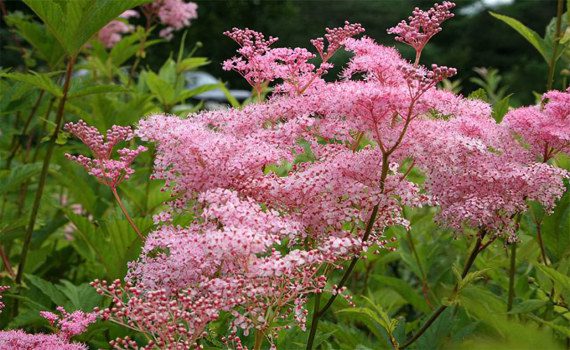
Red meadowsweet is common in the east of North America and therefore has a second name – North American meadowsweet. In Russia, it is found in the regions of the middle zone.
The plant forms a rather lush bush, the height of which can reach more than two meters. Brown-red straight stems are covered with green feathery leaves. During flowering, it becomes clear where the name of the plant came from. Fluffy inflorescences appear on the shoots, formed by reddish or white-pink flowers.
Red meadowsweet is an excellent ornamental plant that is planted in compositions, rock gardens or as a hedge.
Kamchatka meadowsweet (lat. Filipendula camtschatica)

Meadowsweet Kamchatka is common in Sakhalin, Kamchatka, the Kuril Islands, as well as in Japan. Perhaps the tallest species of meadowsweet, growing up to 3 meters in height.
The bush is formed from many shoots, on which there are large (up to 30 cm in diameter) palmate leaves. The color of the shoots and leaves is juicy green. The flowering period begins in July. The meadowsweet bush is decorated with large white-pink inflorescences formed by numerous small flowers.
The Kamchatka meadowsweet is credited with anti-inflammatory, analgesic and antiscorbutic effects, therefore preparations from this plant are used in the treatment of diarrhea, gastrointestinal diseases, epilepsy, poorly healing wounds and bites. The boiled leaves of the meadowsweet are applied to the aching tooth as an anesthetic, while the crushed leaves are used to treat burns.
Hand-shaped meadowsweet (lat. Filipendula palmata)
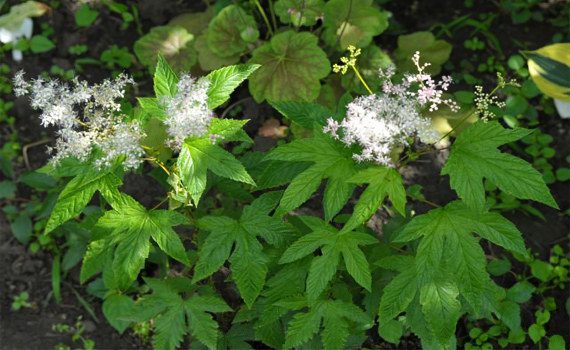
It is considered a medium-sized species, the bushes of which do not exceed 1 meter. The shape of the leaf plates is similar to the palm of a person. The palmate meadowsweet prefers moist soils, and therefore is most often found on the shores of natural and artificial reservoirs.
At the end of July, paniculate inflorescences of 5 small yellowish-white flowers appear on the tops of the peduncles. During flowering, a sweet, very pleasant smell is felt around the meadowsweet bush.
Accepted for: gout, rheumatism, epileptic seizures, spasmophilia, frostbite, burns.
Workpiece
For medicinal purposes, the rhizomes and roots of the plant are used, harvesting them in autumn or early spring before regrowth begins.
They dig the grass with a shovel, clean it from the ground, cut off the above-ground parts and wash it in cold water. The roots are dried under an iron roof or in well-ventilated rooms, spread out in a thin layer on paper or cloth. Store raw materials in well-ventilated dry rooms, packed. The shelf life is 3 years.
[Video] Harvesting meadowsweet (meadowsweet):









